Pink flowers bring a soft yet striking energy to garden spaces.
Whether you're looking for early spring color or blooms that last through summer and fall, pink-flowering plants offer a wide range of choices – from delicate pastels to bold magentas.
This list features 15 dependable and beautiful pink flowers you can grow based on your climate, space, and style.
Whether you want tall, dramatic spires or low-growing mounds, there’s something here for every kind of garden.
Why Pink Flowers Are a Favorite Choice for Gardeners
Pink flowers offer a wide range of tones, from soft blush to bright fuchsia, making them easy to blend with almost any garden palette.
Their presence can soften harsh landscapes, highlight focal points, or fill in bare spots with eye-catching color.
Because pink is neither too warm nor too cool, it works well with white, purple, yellow, or blue flowers – making it one of the most versatile options in garden design.
Beyond aesthetics, many pink-flowering plants are also known to attract beneficial pollinators such as bees, butterflies, and hummingbirds.
This not only brings life and motion to the garden but also supports local ecosystems.
Pink blooms are also popular for creating a sense of calm and relaxation, making them ideal for peaceful garden spaces or outdoor seating areas.
Pink flowers are available in nearly every plant form (trees, shrubs, vines, annuals, and perennials) which means gardeners can include them in containers, borders, beds, and even vertical spaces.
And if you want blooms that hold up through the colder months, you might enjoy this post on tough winter flowers.
Whether your goal is color, structure, or wildlife support, pink flowers offer both beauty and function.
15 Pink Flowers to Add Color and Charm to Your Garden
This list includes a wide variety of pink-flowering plants that work well in different climates, garden styles, and planting spaces.
Whether you're after something tall and dramatic or compact and low-maintenance, each option below offers something unique.
All entries include basic growing information and key characteristics to help you choose what fits your garden best.
1. Peony (Paeonia selections)

Peonies are known for their lush, layered blooms and long lifespan. Many varieties come in shades of pink, from pale blush to deeper rose, and often carry a sweet rose-like or citrusy fragrance.
These plants bloom in late spring to early summer and make excellent cut flowers. Once established, they require little attention and can bloom for decades.
- Zones: 3–8
- Size: Up to 4 feet tall and wide
- Best for: Mixed borders, cutting gardens, low-maintenance perennial beds
Read related post: 15 Gorgeous Long-Blooming Perennials You’ll Want in Your Garden
2. ‘Angelique’ Tulip (Tulipa ‘Angelique’)
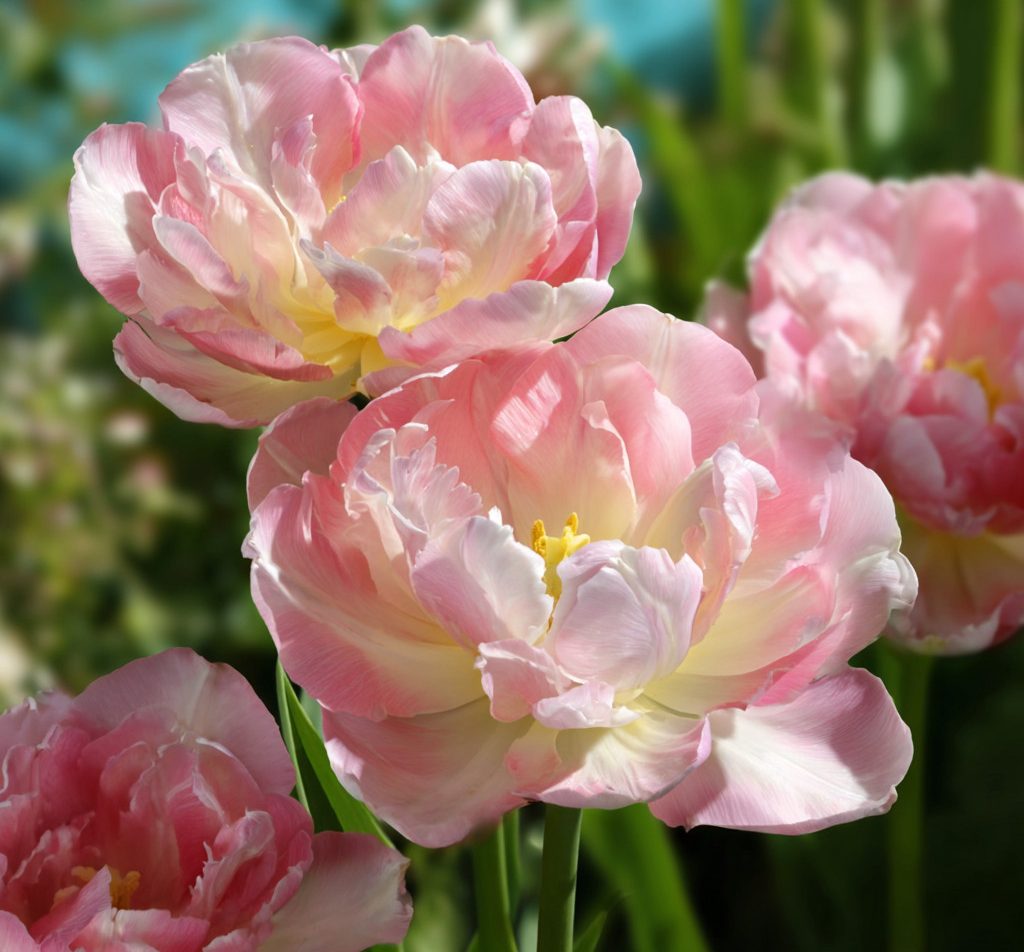
This tulip stands out with its soft pink, double-layered petals that resemble miniature peonies. It’s one of the few tulip varieties known for returning year after year with proper care.
Blooming in mid-spring, ‘Angelique’ adds an elegant touch to spring beds or containers and pairs beautifully with white or pale purple flowers.
- Zones: 3–8
- Size: Up to 15 inches tall and 6 inches wide
- Best for: Spring beds, formal borders, container displays
3. Dahlia (Dahlia selections)

Dahlias are prized for their bold, symmetrical blooms that come in a wide range of pink shades – from delicate pastels to rich cerise.
Flower forms vary from simple singles to large, dinner-plate varieties.
While dahlias need more care than some perennials, the reward is a vibrant summer-to-fall display. In cooler climates, tubers must be dug up and stored over winter.
- Zones: 8–10 (or treat as annuals in colder zones)
- Size: 6 inches to 6 feet tall (depending on variety)
- Best for: Cut flower gardens, sunny beds, statement plantings
Read related post: 20 Fall Flowers to Plant for a Colorful Autumn Garden
4. ‘Carefree Beauty’ Rose (Rosa ‘Carefree Beauty’)
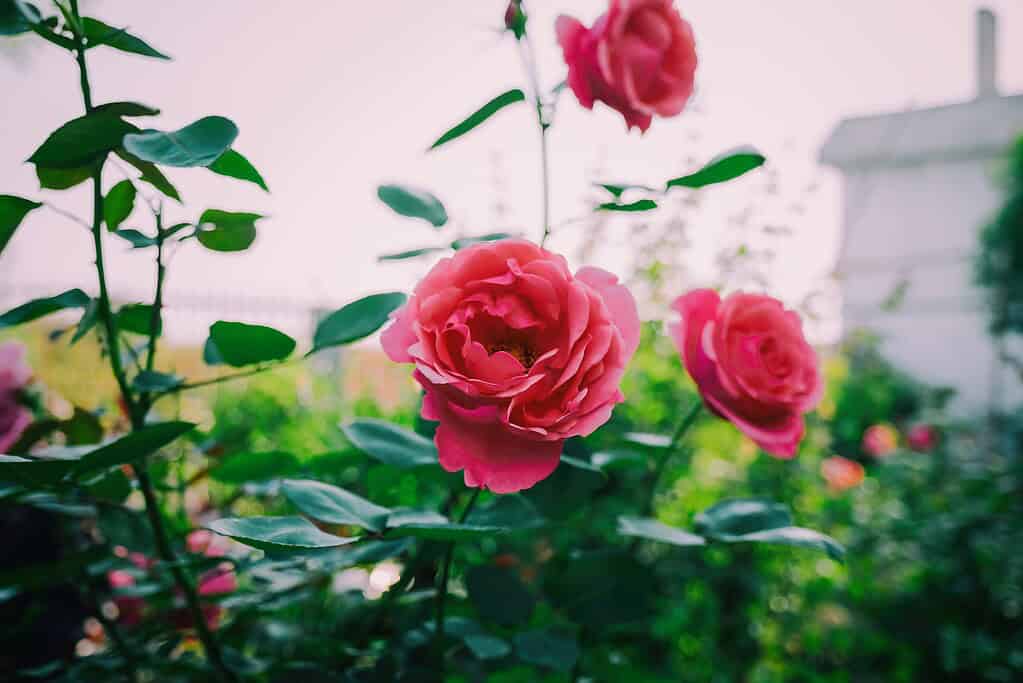
This shrub rose lives up to its name with disease-resistant foliage and generous, fragrant blooms. The semidouble pink flowers appear from early summer through fall with minimal maintenance.
It’s an ideal choice for gardeners who want continuous color without the fuss of traditional varieties. And if you’re growing roses for the first time, you might find my post on how to prune roses helpful for keeping them healthy and full of blooms.
- Zones: 4–9
- Size: About 4 feet tall and wide
- Best for: Informal hedges, rose borders, low-maintenance garden designs
Read related post: 14 Easy Rose Garden Ideas for Any Yard
5. Hollyhock (Alcea rosea)
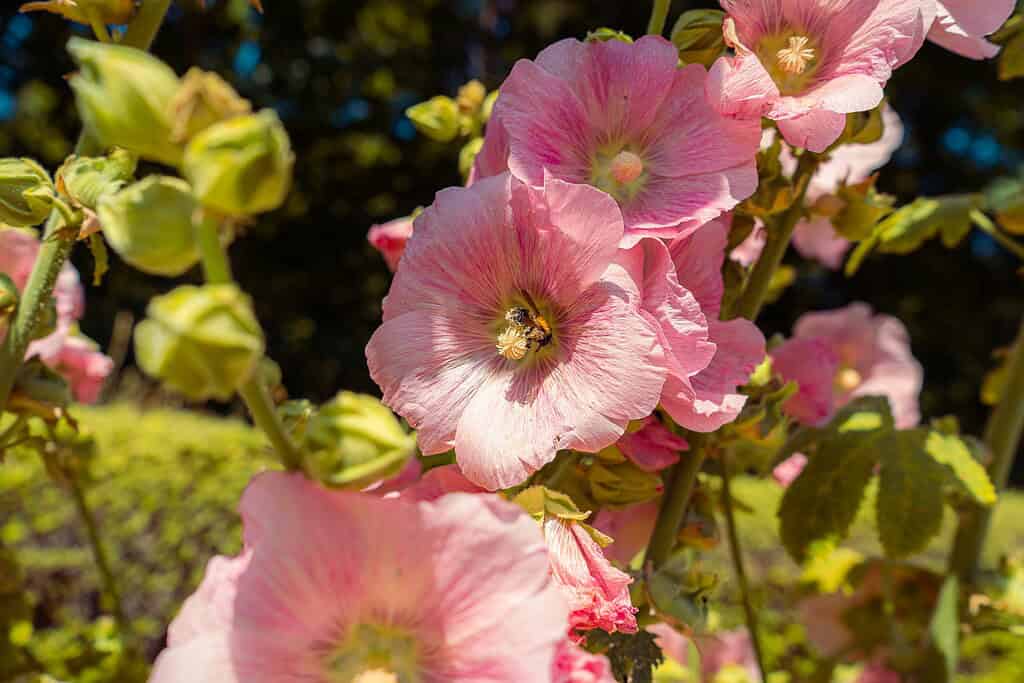
Hollyhocks bring vertical interest to any garden with their tall spikes of hibiscus-like flowers. Pink-flowering varieties range from soft rose to bright pink and bloom from mid to late summer.
These plants are biennials or short-lived perennials, often reseeding themselves to return each year. They work well against walls, fences, or as a backdrop to shorter plants.
- Zones: 3–8
- Size: 3 to 8 feet tall, 1 to 3 feet wide
- Best for: Cottage gardens, vertical accents, back-of-border plantings
6. Fuchsia (Fuchsia selections)
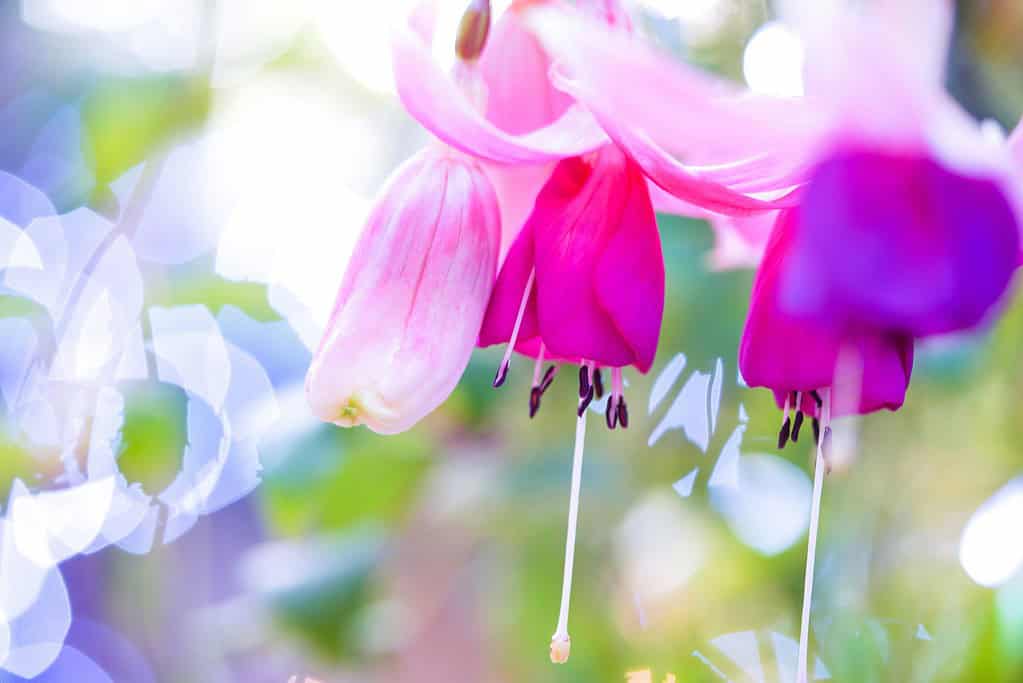
Known for their drooping, lantern-like blooms, fuchsias come in shades ranging from soft pink to deep rose. They add an elegant look to hanging baskets, containers, or shaded beds.
Fuchsias thrive in cooler, moist conditions and are a favorite among hummingbirds. In warmer zones, they can be grown as perennials; elsewhere, they're treated as annuals.
- Zones: 8–10
- Size: 1 to 2 feet tall and wide
- Best for: Hanging baskets, containers, shade gardens
7. Rose Thrift (Armeria maritima ‘Rosea’)

Rose thrift is a compact, mound-forming perennial that produces bright pink, ball-shaped blooms on slender stems. It’s ideal for rock gardens, edges, or small borders.
The grass-like foliage stays neat throughout the season, and the flowers appear in spring and may re-bloom later with deadheading. It’s low-maintenance and thrives in well-drained soil.
- Zones: 3–9
- Size: 6 to 8 inches tall and wide
- Best for: Rock gardens, edging, small-space gardens
8. Hydrangea (Hydrangea spp.)
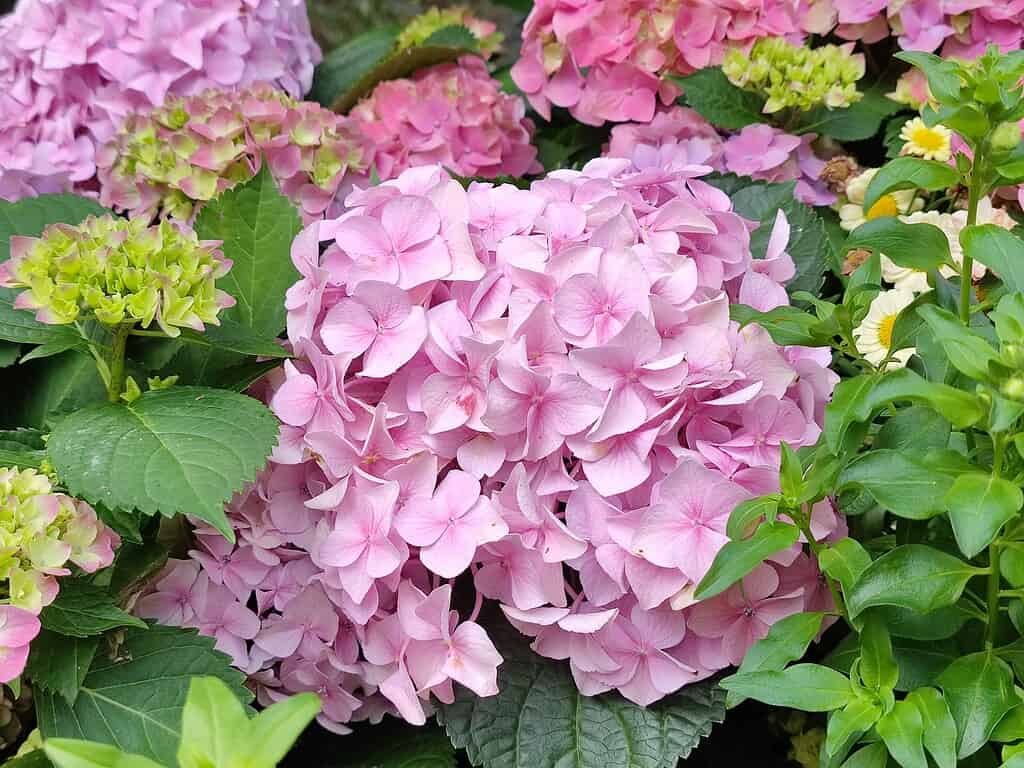
Hydrangeas are known for their large, rounded flower heads and long bloom season. Many cultivars offer pink blooms, especially when grown in alkaline soil.
They bloom in mid to late summer, and some types even re-bloom through early fall.
With options from compact to large shrub sizes, hydrangeas fit in various garden layouts and make excellent foundation plants.
- Zones: 5–9
- Size: 2 to 20 feet tall, depending on variety
- Best for: Foundation plantings, mass plantings, summer color
9. Bleeding Heart (Dicentra spectabilis)
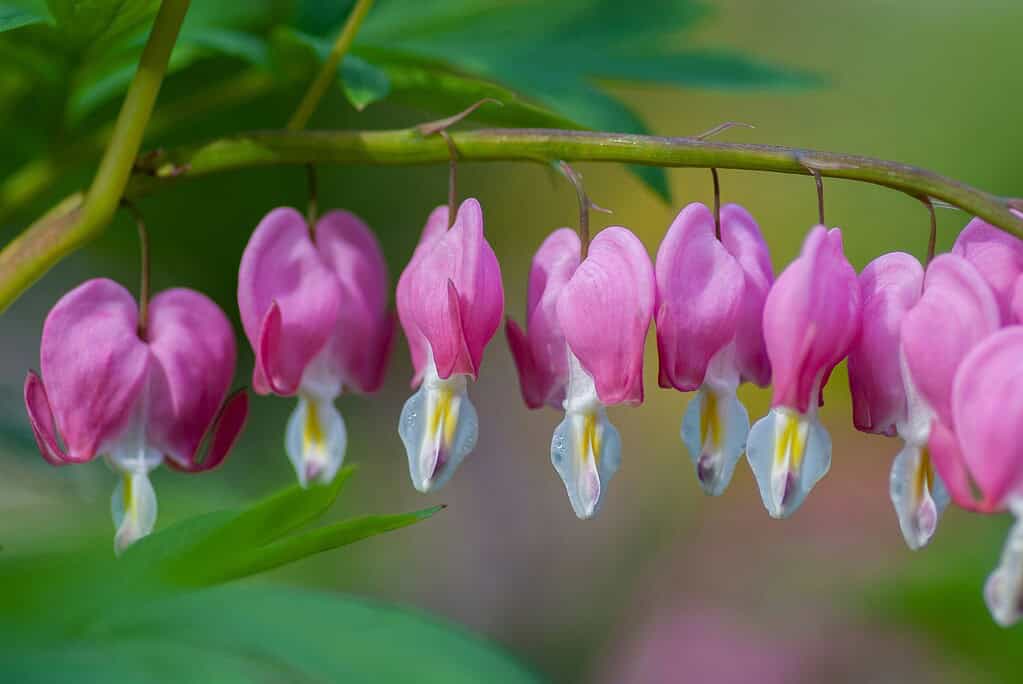
Bleeding heart is a shade-loving perennial known for its arching stems lined with pink, heart-shaped flowers. Blooming in spring to early summer, it thrives in woodland gardens or shaded borders.
The foliage tends to die back in midsummer, so it pairs well with later-emerging plants that can fill the gap.
- Zones: 3–9
- Size: Up to 4 feet tall and 3 feet wide
- Best for: Shade gardens, woodland borders, early-season interest
Read related post: 15 Beautiful Shade-Loving Perennials for Vibrant Low-Light Gardens
10. Rose Campion (Lychnis coronaria)

Rose campion offers vivid hot pink blooms that contrast with its silvery, velvety foliage.
This drought-tolerant perennial blooms from late spring to midsummer and adds a bright accent to low-water gardens. It often self-seeds and can naturalize gently in well-drained soil.
- Zones: 4–8
- Size: 2 to 3 feet tall
- Best for: Dry gardens, silver-foliage borders, naturalized plantings
11. ‘Alice du Pont’ Mandevilla

This tropical vine features bold pink trumpet-shaped flowers that bloom steadily throughout summer. ‘Alice du Pont’ is fast-growing and ideal for covering trellises, arbors, or fences.
While it’s perennial in very warm zones, it’s usually grown as an annual elsewhere or overwintered indoors in containers. It prefers full sun and regular watering during the growing season.
- Zones: 10–11 (annual in cooler zones)
- Size: Climbs up to 20 feet tall
- Best for: Vertical coverage, containers with support, tropical-themed gardens
12. Camellia (Camellia spp.)

Camellias are evergreen shrubs that bloom late in the season, offering pink flowers in fall or winter when few other plants are flowering.
Their glossy, dark green leaves provide year-round structure. Camellias do best in slightly acidic soil with consistent moisture and protection from harsh afternoon sun.
- Zones: 7–9
- Size: 2 to 12 feet tall
- Best for: Woodland borders, shaded foundation plantings, winter color
13. Cosmos (Cosmos bipinnatus)

Cosmos are easy-to-grow annuals that thrive with minimal care, making them ideal for beginners.
Pink-flowering varieties, such as ‘Cupcakes Blush,’ feature soft, crinkled petals that bloom from summer to fall. These plants prefer full sun and poor to average soil, often reseeding themselves for future seasons.
- Zones: 2–11 (grown as annuals)
- Size: 1 to 6 feet tall, depending on variety
- Best for: Wildflower gardens, pollinator beds, low-maintenance plantings
Read related post: 15 Best Annuals That Bloom All Summer Long
14. Garden Phlox (Phlox paniculata selections)

Garden phlox adds mid- to late-summer color with large, fragrant clusters of pink flowers. It’s a favorite for attracting bees, butterflies, and hummingbirds.
These perennials prefer full sun and consistent moisture. Some varieties are mildew-resistant, making them easier to maintain in humid climates.
- Zones: 4–8
- Size: Up to 4 feet tall and 3 feet wide
- Best for: Pollinator gardens, summer borders, cottage-style designs
Read related post: 15 Best Perennials to Plant in Fall for Easy, Beautiful Spring Growth
15. Crabapple (Malus selections)
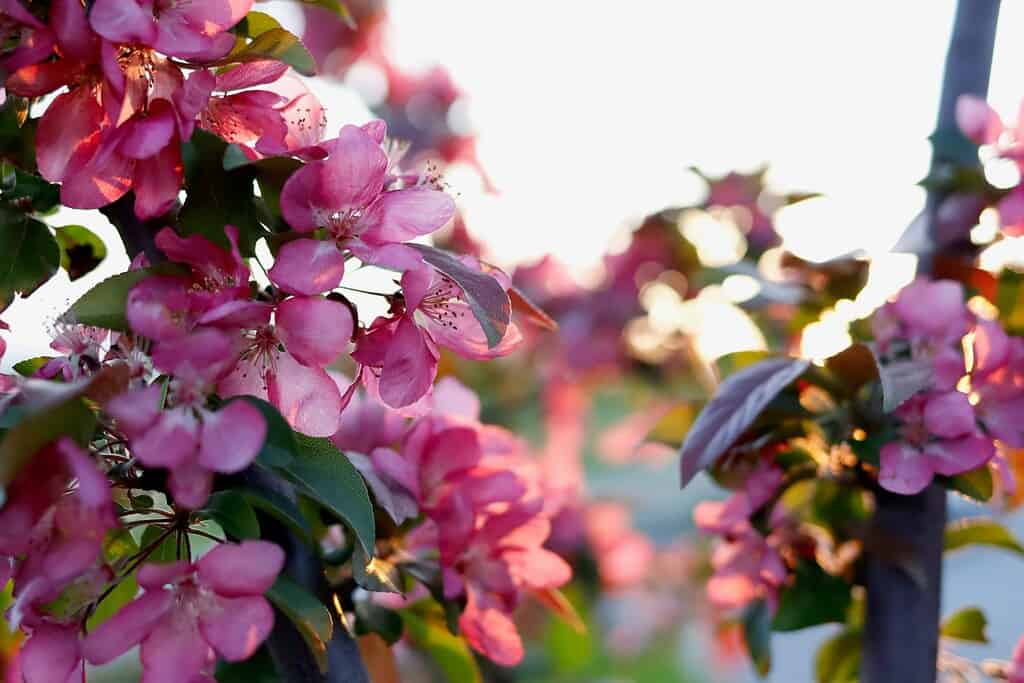
Crabapple trees are among the earliest to bloom in spring, often bursting with pink flowers before their leaves fully emerge.
They provide multi-season interest with colorful blossoms in spring, ornamental fruit in fall, and wildlife value throughout the year.
Varieties range in size from small ornamental types to larger landscape trees.
- Zones: 3–8
- Size: 6 to 25 feet tall and wide, depending on variety
- Best for: Spring interest, ornamental trees, bird-friendly landscapes
If you love adding rich color to your garden year after year, you might also enjoy my list of purple perennials that bring more color to your garden.
Best Conditions for Growing Healthy Pink Flowers
To help your pink blooms thrive, start by matching each plant with the right conditions. Most prefer rich, well-drained soil and plenty of organic matter.
Some love full sun, while others bloom better in partial shade so always check what each variety needs before planting.
Your USDA Hardiness Zone also matters. Cool-climate flowers like peonies and tulips do best in Zones 3–8, while tropical types like mandevilla and fuchsia prefer Zones 8–11.
Choosing plants suited to your zone means reliable blooms year after year.
Water needs vary too. Drought-tolerant picks like cosmos and rose campion won’t need much, but hydrangeas and camellias appreciate steady moisture.
Group plants with similar needs together to make care easier.
For nonstop color, combine early-, mid-, and late-season bloomers and keep them tidy by deadheading.
And if garden space is tight, try containers – many pink flowers (like cosmos, fuchsia, or rose thrift) grow beautifully in pots with good drainage and proper light.
Start Planning Your Pink Flower Garden Today
With so many beautiful pink flowers to choose from, it’s easy to create a garden that offers long-lasting color, seasonal interest, and support for pollinators.
Whether you're designing a new space or adding to an existing one, pink blooms bring warmth, variety, and balance to almost any garden style.
By selecting plants suited to your climate, arranging them thoughtfully, and caring for them throughout the seasons, you can enjoy a garden filled with charm and color from early spring through late fall.
Which pink flowers are you planning to grow this season? Comment down below and share your favorites!
FAQs
What pink flowers bloom in shade?
Some of the best pink flowers for shade include bleeding heart, fuchsia, and certain varieties of camellia. These plants tolerate lower light and still produce vibrant blooms, making them ideal for woodland borders or shaded garden beds.
Can I grow pink flowers from seed?
Yes, many pink flowers like cosmos, hollyhock, and rose campion can be grown from seed. Starting from seed is a budget-friendly way to fill your garden, though some plants may take a full season or more to flower.
How do I keep pink flowers blooming longer?
To extend the bloom period, deadhead spent flowers regularly, water consistently, and feed plants with a balanced fertilizer during the growing season. For repeat bloomers like garden phlox or roses, proper pruning can also encourage new growth.
What are the best pink flowers for containers?
Great pink flowers for containers include tulips, rose thrift, cosmos, and fuchsia. These compact or trailing varieties perform well in pots with good drainage and enough sun or shade, depending on the plant’s needs.
Do pink flowers change color based on soil pH?
Yes, some pink flowers, like certain hydrangea cultivars, can change color depending on the soil's acidity. In alkaline soils, these hydrangeas often turn pink, while acidic conditions can produce blue or purple blooms.
